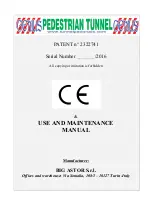
PB-1000 PANEL BEATER
TM
PRODUCT MANUAL
PAGE 20
X. REACTIVITY DATA
Stability:
Stable X Unstable ___
This product is stable under normal conditions at ambient temperature.
Conditions To Avoid:
Prolonged overcharge; sources of ignition
Incompatibility:
(Materials to avoid)
Sulfuric Acid: Contact with combustibles and organic materials may cause fire and explosion. Also reacts violently with strong reducing agents, metals, sulfur trioxide gas,
strong oxidizers and water. Contact with metals may produce toxic sulfur dioxide fumes and may release flammable hydrogen gas.
Lead Compounds: Avoid contact with strong acids, bases, halides, halogenates, potassium nitrate, permanganate, peroxides, nascent hydrogen and reducing agents.
Hazardous Decomposition Products:
Sulfuric Acid: Sulfur trioxide, carbon monoxide, sulfuric acid mist, sulfur dioxide, and hydrogen sulfide.
Lead Compounds: High temperatures likely to produce toxic metal fume, vapor, or dust; contact with strong acid or base or presence of nascent hydrogen may generate
highly toxic arsine gas.
Hazardous Polymerization:
Will not occur
XI. TOXICOLOGICAL INFORMATION
Routes of Entry:
Sulfuric Acid: Harmful by all routes of entry.
Lead Compounds: Hazardous exposure can occur only when product is heated, oxidized or otherwise processed or damaged to create dust, vapor or fume. The presence of nascent hydrogen
may generate highly toxic arsine gas.
Inhalation:
Sulfuric Acid: Breathing of sulfuric acid vapors or mists may cause severe respiratory irritation.
Lead Compounds: Inhalation of lead dust or fumes may cause irritation of upper respiratory tract and lungs.
Ingestion:
Sulfuric Acid: May cause severe irritation of mouth, throat, esophagus and stomach.
Lead Compounds: Acute ingestion may cause abdominal pain, nausea, vomiting, diarrhea and severe cramping. This may lead rapidly to systemic toxicity and must be treated by a physician.
Skin Contact:
Sulfuric Acid: Severe irritation, burns and ulceration.
Lead Compounds: Not absorbed through the skin.
Eye Contact:
Sulfuric Acid: Severe irritation , burns, cornea damage, and blindness.
Lead Components: May cause eye irritation.
Effects of Overexposure - Acute:
Sulfuric Acid: Severe skin irritation, damage to cornea, upper respiratory irritation.
Lead Compounds: Symptoms of toxicity include headache, fatigue, abdominal pain, loss of appetite, muscle aches and weakness, sleep disturbances and irritability.
Effects of Overexposure - Chronic:
Sulfuric Acid: Possible erosion of tooth enamel, inflammation of nose, throat and bronchial tubes.
Lead Compounds: Anemia; neuropathy, particularly of the motor nerves, with wrist drop; kidney damage; reproductive changes in males and females. Repeated exposure to lead and lead
compounds in the workplace may result in nervous system toxicity. Some toxicologists report abnormal conduction velocities in persons with blood lead levels of 50mcg/100 ml or higher.
Heavy lead exposure may result in central nervous system damage, encephalopathy and damage to the blood-forming (hematopoietic) tissues.
Carcinogenicity:
Sulfuric Acid: The International Agency for Research on Cancer (IARC) has classified “strong inorganic acid mist containing sulfuric acid” as a Group 1 carcinogen, a substance that is carcinogen-
ic to humans. This classification does not apply to liquid forms of sulfuric acid or sulfuric acid solutions contained within a battery. Inorganic acid mist (sulfuric acid mist) is not generated under
normal use of this product. Misuse of the product, such as overcharging, may result in the generation of sulfuric acid mist.
Lead Compounds: Lead is listed as a Group 2A carcinogen, likely in animals at extreme doses. Per the guidance found in OSHA 29 CFR 1910.1200
Appendix F, this is approximately equivalent to GHS Category 1B. Proof of carcinogenicity in humans is lacking at present.
Medical Conditions Generally Aggravated by Exposure:
Overexposure to sulfuric acid mist may cause lung damage and aggravate pulmonary conditions. Contact of sulfuric acid with skin may aggravate diseases such as eczema and contact derma-
titis. Lead and its compounds can aggravate some forms of kidney, liver and neurologic diseases.
Inhalation LD50:
Electrolyte: LC50 rat: 375 mg/m3; LC50: guinea pig: 510 mg/m3
Elemental Lead: Acute Toxicity Point Estimate = 4500 ppmV (based on lead bullion)
Oral LD50:
Electrolyte: rat: 2140 mg/kg
Elemental lead: Acute Toxicity Estimate (ATE) = 500 mg/kg body weight (based on lead bullion)
Additional Health Data:
All heavy metals, including the hazardous ingredients in this product, are taken into the body primarily by inhalation and ingestion.
Most inhalation problems can be avoided by adequate precautions such as ventilation and respiratory protection covered in Section 8.
Follow good personal hygiene to avoid inhalation and ingestion: wash hands, face, neck and arms thoroughly before eating, smoking or leaving the worksite. Keep contaminated clothing
out of non-contaminated areas, or wear cover clothing when in such areas. Restrict the use and presence of food, tobacco and cosmetics to non-contaminated areas. Work clothes and work
equipment used in contaminated areas must remain in designated areas and never taken home or laundered with personal non-contaminated clothing. This product is intended for industrial
use only and should be isolated from children and their environment.
The 19th Amendment to EC Directive 67/548/EEC classified lead compounds, but not lead in metal form, as possibly toxic to reproduction.
Risk phrase 61: May cause harm to the unborn child, applies to lead compounds, especially soluble forms.
SAFETY DATA SHEET



































